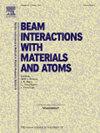直接- ams法测定自然产236U
IF 1.4
3区 物理与天体物理
Q3 INSTRUMENTS & INSTRUMENTATION
Nuclear Instruments & Methods in Physics Research Section B-beam Interactions With Materials and Atoms
Pub Date : 2025-06-03
DOI:10.1016/j.nimb.2025.165763
引用次数: 0
摘要
通过对310个铀矿精矿(UOCs)的多同位素直接- ams调查,测量了~ 2 × 10−12至~ 2 × 10−7之间的236U/238U比值。然而,直接开采的天然铀矿物的范围预计在低-10 - 12到中-10 -10之间。这种高端差异通常归因于乏燃料材料的投入,但在UOC生产的前阶段,多次发生以及缺乏回收任何东西的经济原因使得异常高的236U/238U比率相当令人困惑。当与调查中获得的187Os/188Os比值进行对比时,可以看到236U/238U高值出现在187Os/188Os ~ 10附近,这是一种非随机模式,可以从无意的污染中预料到。这种观察到的相关性有利于那些测量到的高236U/238U比率是自然的,因此,它指的是一个被忽视的自然238U/235U同位素分数机制。因此,这项工作需要进一步研究在更广泛的天然含铀矿物中自然存在的236U/238U。为了确保明确的自然236U调查,本文描述了一种方法,将直接从粉末状天然样品中产生UF5−和离子源重构相结合,以最大限度地减少背景。本文章由计算机程序翻译,如有差异,请以英文原文为准。
Survey of naturally occurring 236U with direct-AMS
From a multi-isotope direct-AMS survey of 310 uranium ore concentrates (UOCs), 236U/238U ratios from ∼2 × 10−12 to ∼2 × 10−7 are measured. However, a range from low-10−12 to mid-10−10 is expected from directly mined natural uranium ore minerals. This upper-end discrepancy would normally be attributed to inputs of spent fuel materials, but the numerous occurrences and the lack of economic reasons to recycle anything in the front stage of UOC production make the abnormally high 236U/238U ratios rather perplexing. When plotted against the 187Os/188Os ratios, which were also obtained in the survey, the high 236U/238U results are seen to occur around the value of 187Os/188Os ∼10, a non-random pattern as might be anticipated from unwitting contaminations. This observed correlation favors those measured high 236U/238U ratios being natural, and as such, it refers to an overlooked natural 238U/235U isotope fraction mechanism. Therefore, this work calls for further studies of naturally occurring 236U/238U in a wider range of native uranium-bearing minerals. To secure unambiguous natural 236U surveys, an approach is described that combines UF5− production directly from powdered native samples and ion source reconfiguration to minimize background.
求助全文
通过发布文献求助,成功后即可免费获取论文全文。
去求助
来源期刊
CiteScore
2.80
自引率
7.70%
发文量
231
审稿时长
1.9 months
期刊介绍:
Section B of Nuclear Instruments and Methods in Physics Research covers all aspects of the interaction of energetic beams with atoms, molecules and aggregate forms of matter. This includes ion beam analysis and ion beam modification of materials as well as basic data of importance for these studies. Topics of general interest include: atomic collisions in solids, particle channelling, all aspects of collision cascades, the modification of materials by energetic beams, ion implantation, irradiation - induced changes in materials, the physics and chemistry of beam interactions and the analysis of materials by all forms of energetic radiation. Modification by ion, laser and electron beams for the study of electronic materials, metals, ceramics, insulators, polymers and other important and new materials systems are included. Related studies, such as the application of ion beam analysis to biological, archaeological and geological samples as well as applications to solve problems in planetary science are also welcome. Energetic beams of interest include atomic and molecular ions, neutrons, positrons and muons, plasmas directed at surfaces, electron and photon beams, including laser treated surfaces and studies of solids by photon radiation from rotating anodes, synchrotrons, etc. In addition, the interaction between various forms of radiation and radiation-induced deposition processes are relevant.

 求助内容:
求助内容: 应助结果提醒方式:
应助结果提醒方式:


